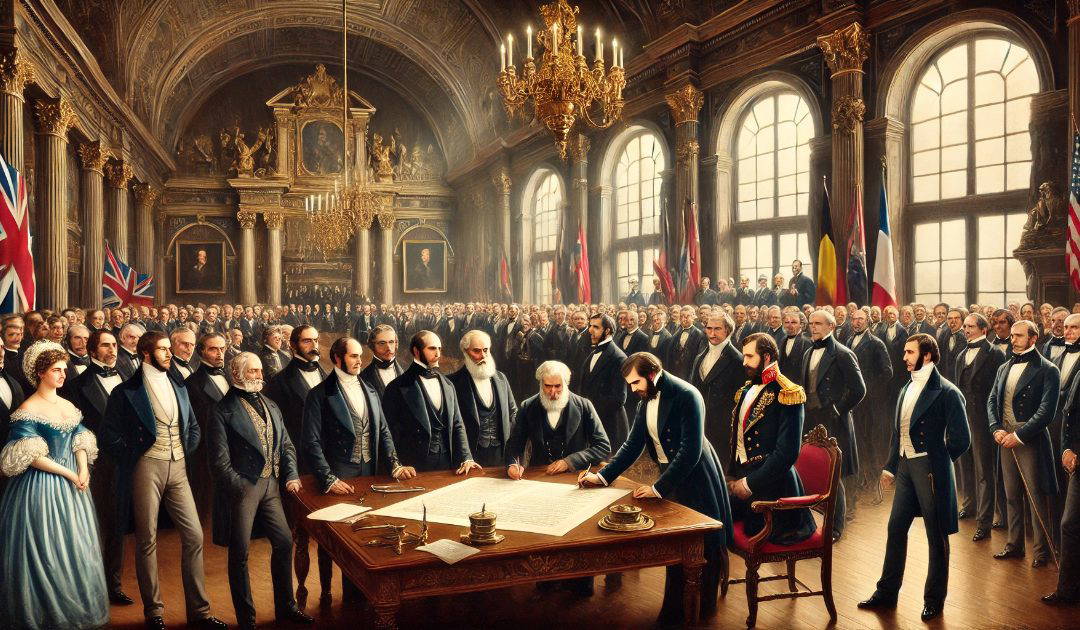The Treaty of London was signed on the 19th of April, 1839. It is a significant diplomatic agreement that played a crucial role in European geopolitics during the 19th century. The treaty is renowned for recognising Belgium’s independence and its perpetual neutrality, a status that lasted until the outbreak of World War I in 1914. This agreement was primarily orchestrated in response to the Belgian Revolution of 1830, in which the southern provinces of the United Kingdom of the Netherlands declared independence, forming what is now modern Belgium.
The Belgian Revolution, which erupted in August 1830, was rooted in various political, linguistic, and religious disagreements between the Dutch-speaking and French-speaking regions of the United Kingdom of the Netherlands. The southern provinces, populated by a Roman Catholic majority and largely French-speaking citizens, opposed the Protestant and Dutch-speaking north’s (Flanders) dominance under King William I.
After gaining independence, Belgium sought international recognition, and the major European powers were keen to negotiate a settlement that would ensure stability. The Treaty of London was the outcome of these negotiations, involving the Concert of Europe—comprising the United Kingdom, France, Austria, Prussia, and Russia.
The Treaty of London of 1839 had several critical provisions that shaped Belgian and European political landscapes:
- Recognition of Belgian Independence: The treaty formally recognised Belgium as an independent and sovereign state. This acknowledgment was crucial for Belgium to establish itself among the European nations.
- Territorial Adjustments: The treaty delineated Belgium’s borders, notably affecting the province of Limburg and Luxembourg. Belgium was to consist of the provinces of South Brabant, Antwerp, Liège, Hainaut, Namur, West Flanders, East Flanders, Limburg (excluding the eastern part), and Luxembourg (excluding the duchy, which remained part of the German Confederation).
- Perpetual Neutrality: One of the most significant aspects of the treaty was the stipulation of Belgium’s perpetual neutrality. Belgium committed itself to remain neutral in any future conflicts, and in return, the major European powers guaranteed to respect and defend this neutrality.
- Scheldt River Navigation: The treaty granted Belgium and the Netherlands equal rights to navigate the Scheldt River, a vital waterway for access to the North Sea and economic prosperity.
- The Treaty of London was pivotal in shaping Belgium’s foreign policy and its international stance for most of the 19th and early 20th centuries. Belgium’s neutrality was respected by the European powers, and it allowed Belgium to avoid involvement in several conflicts that affected the continent.
However, the treaty’s most significant test came with the outbreak of World War I. In 1914, Germany violated Belgian neutrality by invading as part of the Schlieffen Plan. This invasion prompted the United Kingdom to declare war on Germany, citing the Treaty of London as one of the justifications for intervention. This demonstrated the treaty’s enduring significance and its impact on European diplomacy.
Flanders has been a flashpoint of conflict for centuries. When my ancestor Sir Anthony Standen came under the control of Francis Walsingham, Queen Elizabeth I’s spymaster, the first place he was sent was Flanders.
In summary, the Treaty of London of 1839 was a landmark agreement in European history, particularly for Belgium. Its provisions not only secured Belgium’s independence but also ensured its neutral status, shaping its international relations for decades. The treaty’s influence was felt as far-reaching as the outbreak of World War I, highlighting its importance in maintaining European balance and peace in the 19th century. It serves as a reminder of the complexities of European diplomacy and the long-lasting effects of international treaties on the global stage.

